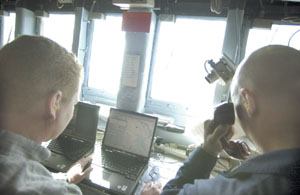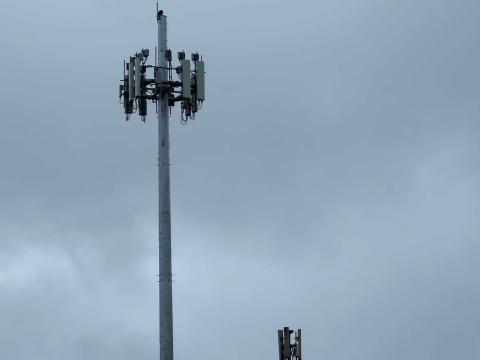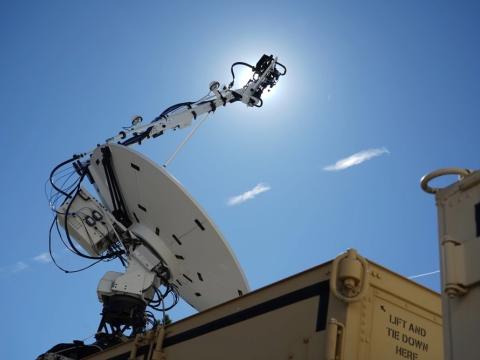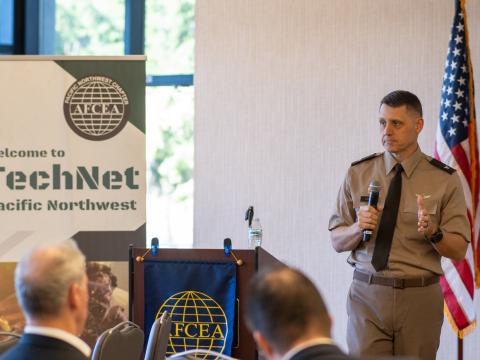Naval Acquisition Takes a New Tack
 |
| Experts from the Naval Surface Warfare Center’s Indian Head Division control operations during a virtual warfare test. The Naval Sea Systems Command (NAVSEA), which runs the Indian Head surface warfare center, has implemented a new acquisition process to speed procurements to its centers while realizing economies of scale. |
The U.S. Navy’s Naval Sea Systems Command is adopting corporate acquisition strategies for buying services nationwide through the Web. A new e-commerce system that expands on a three-year-old model has designated more than 100 industry teams for procurements under a performance-based contracting process. This novel contracting approach also opens new opportunities for small businesses, including set-asides for primes and subcontractors.
The command’s SeaPort Enhanced program, known as SeaPort-e electronic procurement, represents a significant expansion and improvement on the original system, SeaPort. It encompasses the command’s warfare centers across the nation, and it focuses on a host of support activities. These range from support for information system development, assurance and technology to support for ship inactivation and disposal. Among many other focal areas are modeling, simulation and analysis; training; software engineering, development, programming and network support; and interoperability, test and evaluation, and trials.
Capt. Richard F. Sweeney, USN, deputy commander for contracts at the Naval Sea Systems Command (NAVSEA), describes SeaPort-e as a centralized process with decentralized acquisition for officials in the field. He offers that SeaPort-e is evolutionary in that it builds on lessons learned from its predecessor, SeaPort. However, it is revolutionary in the way it allows the command to capitalize on the economies of scale inherent in its national buying power.
The original SeaPort system began in 2001 by providing headquarters-centered professional support services. Contracts qualifying them to bid on specific task orders were awarded to 21 teams of companies. When NAVSEA determined specific work requirements, it would issue an electronic statement of work and invite those teams to bid. On average, 3.6 teams submitted bids for each proposal.
SeaPort did not allow protests of awards. Competitors could appeal to an ombudsman for adjudication, but they could not protest to Congress. The contract also contained a rolling admissions clause, caps on fees and pass-throughs, and a guaranteed savings clause for the conversion of tasks to a performance-based approach.
The new SeaPort-e extends SeaPort across all of NAVSEA’s commands. The effort focuses primarily on the command’s warfare centers. Before SeaPort-e, NAVSEA lacked a single consistent vehicle accessible to all of its field activities, Capt. Sweeney observes. The various warfare centers had hundreds of contracts scattered among roughly 450 contractors. Strategic relationships were limited, and the command suffered from significant duplication in procurement costs.
Unlike many other source selection systems, SeaPort-e is an end-to-end electronic system. At no point in the process does any step revert to paper. Capt. Sweeney explains that the task order is issued on the SeaPort-e Web site to all of the contractors who have a contract under SeaPort-e. Interested contractors reply with electronic proposals, which are evaluated online. The contract award also takes place online.
Another advantage of SeaPort-e is that it features a compressed process. Where previous service contracts would take an average of 12 to 18 months to generate, SeaPort-e allows contracts to be awarded in typically one to three months. Awards for more than $50 million should take about eight weeks, while awards for less than $50 million should take slightly more than four weeks. Currently, those awards are running somewhat behind these goals at 11 weeks and five weeks, respectively, but those times are dropping.
Simplified logistics steps are only part of the picture. Capt. Sweeney imparts that SeaPort-e also leverages NAVSEA’s buying power for the first time. This allows the Navy to realize volume discounts to the maximum extent possible. NAVSEA is able to receive “good deals” on its purchases because SeaPort-e brings to bear the purchasing power of the entire NAVSEA organization on its acquisitions, the captain relates.
The influence of SeaPort-e can be felt across the full range of NAVSEA’s $1.3 billion worth of service contracts that are run through the command’s warfare centers each year. Over the 15-year life of the SeaPort-e effort, these contracts add up to more than $19 billion, most of which will go through SeaPort-e, Capt. Sweeney allows.
The command conservatively estimates savings of from 7 to 10 percent, he adds. In its solicitations for bids on SeaPort-e task orders, companies were told that their proposals would not be evaluated favorably if their fees were greater than 8 percent. SeaPort-e also established limits on pass-through rates of 5 percent. Ultimately, companies came in with a fee average of 7.56 percent and a pass-through average of 3.46 percent.
The biggest challenge in expanding SeaPort to SeaPort-e was obtaining the support of the warfighting centers, the captain offers. While NAVSEA headquarters provided the program manager and some of the corporate knowledge of the original SeaPort, the warfare centers ran the multiple award contract (MAC) competition. All of the contracts’ directors were involved in putting together the requirements and then evaluating the proposals from industry.
While the original SeaPort featured 21 MACs, the new SeaPort-e expands that to 151 MACs. Capt. Sweeney explains that NAVSEA also is looking for support to more functional areas—21—than before. Also, with SeaPort-e now covering all of NAVSEA’s organization across the entire country, the command has divided the country into seven geographic zones for SeaPort-e implementation. Some contractors are geared toward providing support in one or more particular zones while not participating in the others. This is why the number of MACs has increased dramatically.
The number of contractors varies by zone. It ranges from a high of 104 contractors in one zone to 68 in another.
Task orders are completed in the zone that corresponds to the principal place of performance. However, contractors are awarded MACs within a single zone or multiple zones. All told, the 151 MACs comprise about 800 contractors and subcontractors. The command has reserved the right to expand the field of 151 if it believes that it is not seeing adequate competition or if it adds new areas of work.
Capt. Sweeney observes that the SeaPort-e zone approach has driven consistency on both the Navy side and the contractor side. Large companies that have multiple business units across the country can obtain a single contract through SeaPort-e instead of having separate units submit proposals for each warfare center under the old SeaPort. Now, SeaPort-e allows a company to bid a single proposal.
Another asset offered by SeaPort-e is that it provides business intelligence, the captain notes. NAVSEA officials can track proposals on each task order and see how long it takes to make awards to which companies, he says. Officials also can find out which kinds of companies are competing in different areas and whether the command is achieving sufficient competition in each functional area. SeaPort-e provides an evaluation on the performance of each of the contractors that has completed work.
Officials also can determine how long each phase of an acquisition takes, and they can use this information to decide where to employ more resources. For example, if the requirements definition is taking too long, then efforts must be directed at the front of the acquisition. Similarly, if too much time is being spent on conducting the source selection evaluation, then officials can address that problem. “We can track the progress of some things a lot better than we could in the past [and] to a much greater level of granularity,” Capt. Sweeney says.
A key element of SeaPort-e is that the new iteration opens up more opportunities to small business. Capt. Sweeney observes that planners thought that the original SeaPort contract vehicle would serve small business well. NAVSEA solicited any companies that provided program office support services for SeaPort, and of the 21 companies awarded contracts under that original program, seven were small businesses. The command thought that these seven companies would compete well for task orders under the MAC. However, it did not receive as much business from them as it would have liked, the captain relates.
So, the development of SeaPort-e included measures to rectify that shortcoming. Of those 151 MACs, 103—more than two-thirds—were awarded to small businesses. The MAC small-business goals include spending 33 percent of obligated dollars to small business primes, while 20 percent of obligated dollars awarded to large businesses will be subcontracted to small businesses. Guidelines call for actual subcontract performance to be a factor in task order evaluations and award term decisions.
Capt. Sweeney also notes that SeaPort-e is pursuing a different market than SeaPort. The new system supports the command’s field activities, and they tend to involve research and development. This work in turn relies a great deal on small innovative companies for providing necessary services. “While we were looking to leverage our national buying power, we wanted to make sure that this vehicle didn’t do that to the detriment of the innovation that small businesses provide us,” he explains.
SeaPort-e includes the ability to set aside contracts for small businesses, which was absent from the original SeaPort. In addition to conventional small business set-asides, the new version also includes a cascading set-aside capability. If NAVSEA receives two competing small-business proposals in response to a requirement, it can issue a statement establishing a task order set-aside for small business. “We need to get better small-business participation in SeaPort Enhanced because of the customers that those companies will be supporting—and because we would like to get better small business participation as well,” Capt. Sweeney declares.




Comments